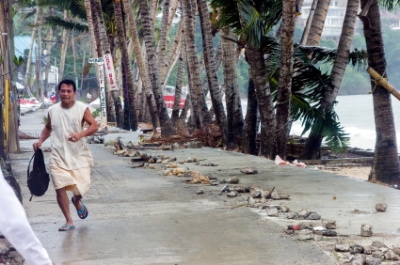 It has been 10 days since Typhoon Haiyan, one of the most powerful typhoons ever recorded, first hit the Philippines and left in its wake a nation devastated and in desperate need of aid. As a Filipino American with extended family in the Philippines, this disaster struck a chord close to my heart. The personal connection, however, was unnecessary to appreciate the true tragedy of what has occurred and what is ongoing, as relief is trickling into the country, slow to reach those most in need. The category 5 typhoon reached 195 mph with gusts of up to 235 mph; however, the gravest numbers are of the human loss, starvation, and displacement.
It has been 10 days since Typhoon Haiyan, one of the most powerful typhoons ever recorded, first hit the Philippines and left in its wake a nation devastated and in desperate need of aid. As a Filipino American with extended family in the Philippines, this disaster struck a chord close to my heart. The personal connection, however, was unnecessary to appreciate the true tragedy of what has occurred and what is ongoing, as relief is trickling into the country, slow to reach those most in need. The category 5 typhoon reached 195 mph with gusts of up to 235 mph; however, the gravest numbers are of the human loss, starvation, and displacement.
Numbers reported by NBC News capture the tragic toll thus far:
The Philippine government says 9.8 million have been affected in 44 provinces, 539 municipalities, and 56 cities. Of those affected, 4.9 million are children; 1.5 million are children under the age of five who are at risk of Global Acute Malnutrition (GAM), a measurement of nutritional status used to assess the severity of a humanitarian crisis.
A recent report from the U.N. lists the death toll at 4,200. The Philippine government disputes this figure and has reported 3,637 deaths as of this Saturday. According to the Philippine disaster council, 1,186 are still missing.
The U.N. requested $300 million for the Haiyan Action Plan to provide supplies and services to those affected by the typhoon. So far, $81 million has been contributed by donors, including U.N. member states and the private sector, including more than $20 million from the U.S. IKEA, yes that IKEA, pledged $2.7 million.
Despite the money pledged, much-needed basic aid such as food and water has been slow to arrive to those who need it most in the Philippines.
According to U.N. estimates, 2.5 million people are in need of food assistance. However, as of this past Friday, 375,795 people had been assisted through food distribution, including rice, high-energy biscuits, and canned goods, according to the U.N. Office for the Coordination of Humanitarian Affairs (OCHA).
One day after the typhoon struck, the Huffington Post published a list of relief efforts, which has since been updated and is provided below in no particular order. You can read about Chicago-based relief efforts here. I encourage you to do what you can.

The U.N.’s hunger-fighting organization has allocated an immediate $2 million for Haiyan relief, with a greater appeal pending as needs become apparent. The UN organization is sending 40 metric tons of fortified biscuits in the immediate aftermath, as well as working with the government to restore emergency telecommunications in the area. Americans can text the word AID to 27722 to donate $10 or give online. Learn more here.
Anticipating that children will likely be among the worst affected by the typhoon, UNICEF is working on getting essential medicines, nutrition supplies, safe water and hygiene supplies to children and families in the area. Learn more here.
CRS will provide shelter, water, toilets, and more. The charitable arm aims to provide temporary housing for 32,000 families in three areas. Learn more here.
The emergency response and global health organization is sending medical aid for 20,000 survivors, including antibiotics, wound care supplies, and pain relievers. AmeriCares is also giving funds to local organizations to purchase supplies. Learn more here.
The Christian humanitarian organization that specifically supports families living in poverty is providing food, water, and hygiene kits at the evacuation centers. World Vision was also still actively responding to last month’s earthquake in Bohol, which fortunately was not struck by the eye of the storm. Learn more here.
ShelterBox, an emergency relief organization, provides families with a survival kit that includes a tent and other essential items while they are displaced or homeless. Learn more here.
The Philippine Red Cross has mobilized its 100 local outposts to help with relief efforts. Learn more here.
The humanitarian and disaster relief organization has sent emergency responders and volunteers to provide meals and relief items. Already, thousands of hot meals have been provided to survivors. Red Cross volunteers and staff also helped deliver preliminary emergency warnings and safety tips. Give by donating online or mailing a check to your local American Red Cross chapter. Learn more here.
Save The Children
The organization, which prioritizes kids’ needs, has sent relief kits for children and families, including household cleaning items, temporary school tents, and learning materials. Learn more here.
The international medical humanitarian organization is sending 200 tons of medical and relief items, including vaccines, tents, and hygiene kits. Learn more here.
The Los Angeles-based nonprofit is sending much-needed water purification supplies to victims and seeking corporate partners to help with delivery. Donate $10 by texting AID to 50555 or give online. Learn more here.
American Jewish Joint Distribution Committee
The humanitarian assistance organization, which fights global poverty in 70 different countries, is sending disaster and relief development experts to aid in recovery. The organization is also empowering local partners in their efforts. Learn more here.
LWR, which fights poverty by improving global health and ensuring basic human rights are met, is working with local partners to provide water, shelter, financial resources and recovery efforts. LWR is appealing for $2.5 million for its typhoon relief fund. Learn more here.
The nonprofit, which galvanizes first responders and veterans to help in times of crises, has sent a group of specialists to aid in search-and rescue, medical triage and medical relief. Learn more here.
The emergency response team is providing infection control, clean water and food to families in the hardest hit areas. Learn more here.
The International Rescue Committee
The organization, which specializes in humanitarian crises, is sending a relief team to help provide water and sanitation systems. Learn more here.
The international poverty-fighting nonprofit, which provides sustainable global food and water solutions, is distributing drinking water, buckets, soap, and chlorine tablets. It’s also providing sanitation equipment to help prevent waterborne diseases. Learn more here.
